#ico castle in the mist
Explore tagged Tumblr posts
Note
15, for the book ask meme
15. recommend and review a book.
OH, here's one. Ico: Castle in the Mist, by Miyuki Miyabe (trans. by Alexander O. Smith).
it's an adaptation of the video game ICO, and about a boy with horns offered to a castle as a sacrifice bc they thought him an evil omen, and he escapes his imprisonment in said castle and helps this ghostly glowing girl escape as well from the queen of said castle. The game itself has like, no dialogue, and there's story but not like, exposition. Not much of it from what I remember. Definitely not what's in the book.
The book offers a lot more exposition and character talk. It's been ages since I read it tbh but the experience was special. I read it while playing the game, pacing it so I was at the same points in both the game and the book and going through it as I did. It just really enhanced the story. I got the wonderfully written story expanding the original ICO while interacting in the world with the beautiful soundtrack and giving myself time to go through both at my own pace.
I think the book itself is quite nice on its own, and a good extension if you enjoyed the ICO game
5 notes
·
View notes
Text
You were there...

#ICO#team ico#ico game#ico art#ps2#ps2 games#playstation#retro gaming#fumito ueda#castle in the mist#yorda#ico yorda#background#art#fanart#colored#artists on tumblr#video games#game art#digital art#wanted to draw them for a very long while
60 notes
·
View notes
Text
I stumbled across a Japanese article where Fumito Ueda, Yoko Taro, and Keiichiro Toyama had a publicized discussion about their careers and the video game industry as whole. This discussion was organized primarily to celebrate ICO's 20th anniversary in late 2021. So the folks over at Den Faminico Gamer requested concept art from all across ICO's development cycle to present throughout the 3 pages of conversation. And I don't know who was responsible for the task of transferring that, but they gave them A Lot of concept art. Many of these sheets have not been shared by genDESIGN's twitter, or really seen on any other site to my knowledge. There's some exclusive stuff in here. And even if they were seen somewhere before, I still want to translate them to the best of my ability and share the info. So I'm going to guide you through the sheets I found the most interesting. I'll also try to provide context for any cut content and musings on the lore elements being spelled out on the page. [Spoilers for ICO under the cut]
CUT AREAS
Jail

[I've decided to leave the original page untouched in all my translation images, and keep all added text to the black bars at the sides. I'm also including plain Japanese text in dark grey, just so everyone is clear on how I am interpreting the handwritten notes.] This area is titled "Jail" or "Prison" and it was to be put on the second story of the East Arena. This means that, in early designs, the leftmost door was meant to be opened on arrival. It seems you would navigate the diagonal water slope, make it up to this area, and briefly move outside for the sake of slipping into one of these locked cells. After doing so, you move a shelf aside, find the sword, enter a fight, and then use the sword on the rope holding the far right arena door. Having a jail cell next to the arena is very intriguing from a narrative standpoint. Were the cells for those who broke the rules set in place by the arena's organizers? Or was the arena always intended to be sparring matches between criminals and outcasts? Why is the only way onto the balcony found through one of these cells?
Boatshed
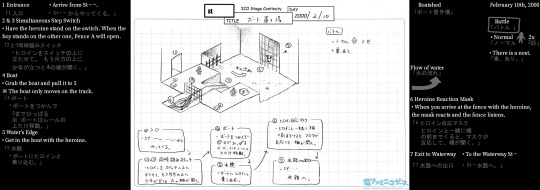
[In the black bars, text relating directly to the contents of the sketch will have drawn elements next to them, so you can better see what translation is paired with what part of the drawing. If it ever gets confusing, shoot me an ask and I'll clarify/edit the post.] The day after drawing up the concept for the Jail area, the team sketched the Boatshed, which was also cut. This area is reflective of an earlier, less bombastic ending to ICO, which Ueda briefly mentioned during Sony's "Great Scene Sharing" campaign in 2011.
Also, to be honest we weren’t planning to have the castle collapse entirely like that. We were originally thinking to have the ending of ICO be much more modest, but somehow it didn’t give you a feeling of resolution that way. And so we decided “Ok, let’s make everything crumble into the sea then.” (laughs)
The most intriguing aspect of this cut concept is a kind of Idol Fence Gate that reacts to Yorda in the same way as the Idol Doors, only in this case it is powered by a mask. The mask's face shape is somewhere between a man and a bull, with the moderately sized horns completing the animal resemblance. There seems to be a gem or circular marking embedded into the forehead as well. The text makes mention that the gate 'listens' to the mask (assuming I'm translating that correctly), so perhaps it had a specific auditory or musical cue planned for when it reacts to Yorda? But perhaps not. A concept page like this would be the perfect place to write that idea in clear detail, after all.
Heroine Room Connection
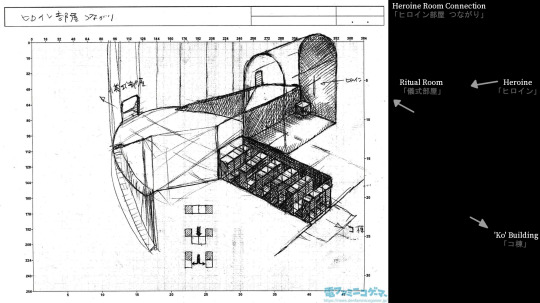
This is not exactly a cut area, but it is certainly a heavily altered one. This spot would later become the floor of Spiral Staircase, where Yorda is held prisoner in the first act of the game. We can see this intention by its proximity to 'The Heroine's Room' and the series of Idol Doors set up as the introduction to Yorda's unique power. (There's even a sketch detailing how this arrangement of four idols are supposed to part when opened, and it matches up with the movement of the idols in Spiral exactly.) The most notable feature of this area seems to be a set of stairs leading up into a small room with a trench in it. In the trench is a box and a small crevice in the wall. The crevice is labelled 'Heroine', which, to me, implies that Ico might have been able to see or hear Yorda through this crack in the wall. But since this room is a dead end, I imagine you use the box in some way to activate the other set of stairs, which seem to have both a upward and downward status depending on whether you've solved the puzzle or not. This is very similar in concept to a puzzle presented elsewhere in the final game. At either ends of the room are two doorways. One direction is labelled 'Ko Building', which we will discuss later in this post. But the entrance to this room is through the Ritual Room... which we also have concept art for!
Ritual Room
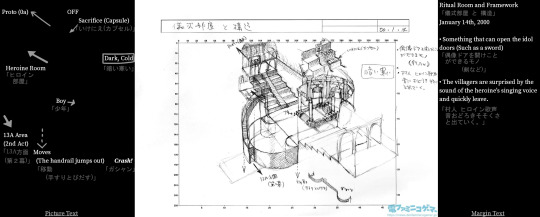
Similarly to the last sheet, this sketch depicts elements that would end up placed elsewhere, but the overall design of this room was cut. The Ritual Room was seemingly designed before the team had come up with the final design of the Altar Room. The Ritual Room bears many of its elements, but has a much larger scope and seems to serve as a junction between several parts of the building.
Common elements include:
The floor raising and lowering to open a path to the Stage 13 Elevator. The notes even clarify that this will only occur in the game's "2nd act". In this version of the mechanism, a handrail rises up when the floor lowers.
Capsules in which to place sacrifices. Though they aren't clearly depicted, they seem to be embedded into the ground, rather than standing up.
Restricted access to the high up Idol Doors. In the final game, they lead to The Queen's throne room. Here it leads to Proto, the earliest room designed in the game. It's unclear how you earn access to the doors, but the 'OFF' label indicates that the stairs must rise, or else it remains a vertical wall.
But one big difference that stands out is the palanquin-like structure at the center, which reminds me of the structure that surrounds The Queen's throne. Given the title of the room, we can infer this was meant to be the spot where the Queen's ritual would be held.
Notes in the margins indicate two innocuous, but fascinating things: - The note regarding what might open the Idol Doors for the village men likely marks the conception of The Queen's Sword. - Yorda's voice was meant to be heard from this room, and she would've been singing. She doesn't get to sing to herself in the finished product, though I think that characteristic fits her well.
Flowchart of the Second Half
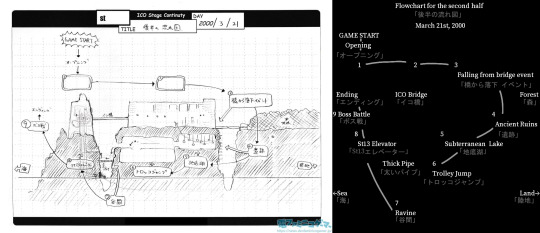
Once it became clear to Ueda that the ending had to be more resolute and bombastic, they devised the Main Gate Event and laid out a plan for all the places you would traverse on your journey to the throne room. You might notice that locations like Cliff Cage, Cogwheel, and Pipe have different prototype names and some visual differences. The first location on the journey back, later known as Cage, is titled 'Ruins'. It seems to feature a series of overhang structures jutting out from the cliff-side. Presumably, these would catch Ico after his fall. The titular cages of the present incarnation seem to be absent, but we can see them close by, in the area that will become known as Cogwheel. Instead named 'Subterranean Lake' in this document, Cogwheel seems to lack any of its characteristic mechanisms. In this sketch, one of the cages seems to have fallen from the ceiling into the water below. In the final game, we move from Cogwheel to the outer edge of the island, where Ico clings tightly to the ridges of the cliff-side. But in this concept art, all of that distance is spent on a new area, completely cut from the final release, called 'Trolley Jump'. It seems the trolley would make a second appearance in the game's puzzle design and Ico would have to build up momentum to make it over a huge gap in the tracks. The Pipe area is named 'Ravine' instead. And the metallic platform is set far lower than it is in the final game, where you can just walk across it to make it to the elevator. Here, you must descend onto it and then climb up into a cavern, once you make it to the other side. You might've also seen that the the Old Bridge is titled 'ICO Bridge' in this document. This is especially interesting to me, as the name ICO seems to serve a different purpose here than you would expect.
What is “ICO (イコ)”, really?
Kenji Kaido has stated in the Japanese Guidebook for the game that the name 'ICO' was just the title, and initially, was never attributed to the boy protagonist (Page 82). He was nameless and only referred to as 'Boy', much like the protagonist of The Last Guardian is currently. The game's filenames, the concept art, and even Kaido's own presentation of the E3 2000 demo to PlayStation Underground, back this sentiment. The term 'ICO' is never attached to the boy before June or July of 2000, when US gaming publications reporting on E3 2000's demo started conflating the title with the protagonist's name. Seeing as this is dated in March of 2000, it's safe to say the use of 'ICO' here has nothing to do with the boy. So what is it about? Ueda did also say that the name was a shortening of the term ICON... but I have additional evidence suggesting that in this specific instance, it was not serving as an abbreviation for 'ICON Bridge'. Take a look at this rough overview sketch from the margins of a different concept art page.

Aside from the points that indicate land and sea, the labels that plainly stick out are "イ棟" and "コ棟".
"I Building" and "Ko Building". We saw that last label earlier in the Heroine Room Connection section.
Knowing this, we can safely infer that it's called イコ Bridge because it connects the イ and コ buildings... But then why are they split in that way and labelled イ and コ? I still don't have an answer for this, though I do feel like the divide is related to the separation of class. The イ building is dedicated to The Queen. It contains both her daughter and the sacrifices she needs to complete her ritual. It's where her throne is. It's where she resides and does her work. Meanwhile, everything on the other side of this bridge seems to have been built for a larger populous.
Benches, recreational areas, spectated arena matches, a waterfall, a courtyard, a ballroom with a massive chandelier! You don't build a front gate and a bridge to the mainland if you never wanted people to enter... This place undeniably once had people who lived and worked here. They were all designated under the コ building. I have to imagine this is why a distinction is being made, but beyond that, the reasoning for the titles remains a mystery. If someone has further insight into Japanese linguistics or culture, and have additional guesses as to why, please let me know.
Cut Boss Fight

In the West Arena (labelled 'R' for 'Right' in early development), there was going to be another raised cage event. Only this time it would take the form of a boss fight with a massive shadow that overtakes the floor and splays black tendrils through the air. Interestingly, there is already an overhead bridge in this image, but rather than magically appearing in stone segments, it's instead an ordinarily constructed wooden bridge. Here, the notes detail a different kind of puzzle element: Wire. Which, unlike ropes, cannot be cut by the sword. The same note indicates that wire is holding the left and right doors in place. While the concept art doesn't detail it plainly, I believe the only way past this room would be to pull on the "Idol Handle" that the boss is covering. Wire is also presumably being used for the zip-line running across the arena, which is an interesting component to say the least. The vision I'm gathering is that you'd ride the zip-line, hit X at the right time to drop down onto the overhead bridge, run over to the balcony where the 'Cage Switch' is labelled, and activate it to impede the boss. How it is then defeated is less clear. It's also unclear where Yorda would have been throughout this encounter, or if there would be additional enemies trying to drag her into a nest. Its possible the boss itself would be programmed to capture her with a tendril, and itself act as a nest by dragging her into the depths of itself. But we have no evidence one way or the other. [Ok, that's all the stuff I have to present for now. Keep in mind that there's more to see and translate in the article I linked at the very start. This post was only scratching the surface, despite the amount of material we covered. With that in mind, thank you for making it this far.]
Support
Now is as good a time as any to mention I've started up a Ko-Fi, so people can choose to support the work I do to uncover and present obscure info like this. There is, of course, no obligation to give me anything. The tips just help me get a bit of financial security in return for my efforts.
#ico#yorda#team ico#concept art#long post#translation#fumito ueda#cut content#obscure gaming trivia#new gaming discovery#japanese to english#the castle in the mist#ps2#ko fi link
30 notes
·
View notes
Text
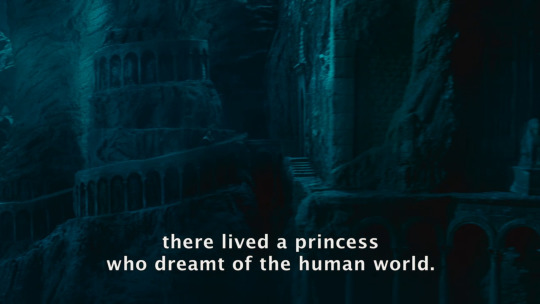

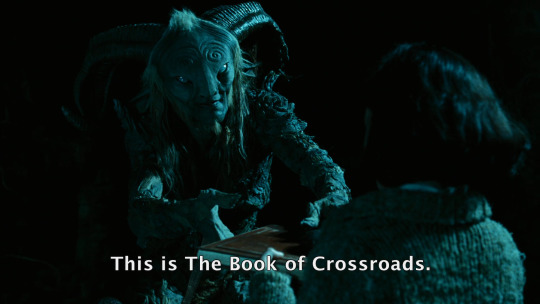
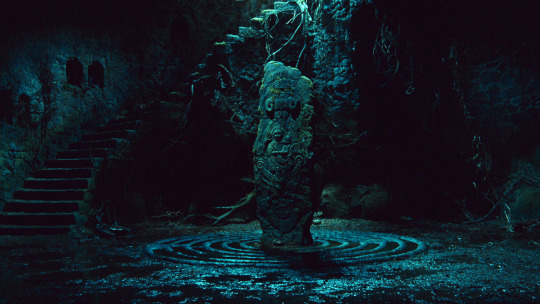


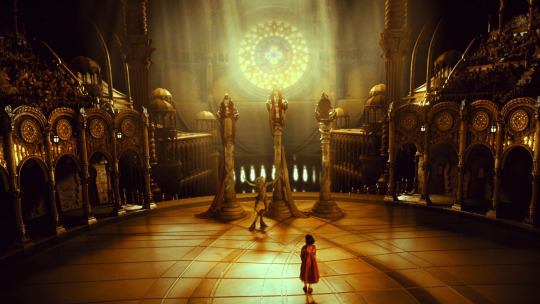
Guillermo Del Toro was inspired by Ico and Shadow of the Colossus when he made El Laberinto del Fauno (Pan's Labyrinth).
It’s well known that Guillermo Del Toro is a huge fan of Ico and Shadow of the Colossus. The second game came out around the time filming of Pan’s Labyrinth was concluding, but I think it’s quite likely that del Toro would have watched trailers for it. His film is often described as a fairy tale for adults, and it occurred to me how well that describes Ico. Shadow of the Colossus is more like a Greek myth. The first shot of the movie shows Princess Moanna leaving her kingdom through ruins that are very reminiscent of the castle in Ico. Ofelia speaks to the faun in a place with a spiral staircase that's reminiscent of where Yorda is suspended in her cage. Both we and Ofelia are told that she is in fact Princess Moanna, Moanna's soul having returned in her body. When she finally escapes her fascist captor, she glows like Yorda and is reunited with her family as the princess in an afterlife kingdom.
I wrote a post here about Le Roi et l’Oiseau (The King and the Mockingbird) as a source of inspiration for Fumito Ueda. It's an adaptation of Hans Christian Andersen's The Shepherdess and the Chimney Sweep, which features a faun/satyr, the same creature with the hind legs of a goat and horns (like Ico) that we see in Pan’s Labyrinth. The ending music, which is also the lullaby that Mercedes hums to Ofelia, sounds a bit like ‘La Bergere et le Ramoneur’ from The King and the Mockingbird which I have previously suggested could be an inspiration for 'Castle in the Mist'.
The Legend of Zelda: Ocarina of Time - Ofelia is guided by fairies. Two fairies are effectively ‘used up’, saving her from being killed. The Great Deku tree. The monster sitting at the table looks like a ReDead and when he places his eyes into his hands, it reminded me of Bongo Bongo, the Shadow Temple boss.
Various movie influences - A girl rescuing her baby brother in a labyrinth is like Labyrinth. Doors created by drawing an outline with chalk is from Beetlejuice. Ofelia wears a pair of red shoes like Dorothy in The Wizard of Oz. Alice in Wonderland.
Pan's Labyrinth feels very like a video game and as much like a Greek myth as like a fairy tale. It's something I feel I should have thought of before, how much the quests you go on in action-adventure and RPG games are like those in classical mythology. Think of how Ofelia has to complete three tasks, face three monsters and is rewarded with special items. Her first task, for example, is to get three stones into the mouth of a giant toad for which she is rewarded with a special key. It's amazing how Guillermo del Toro manages to thread this fantasy world together with a real world situation of Ofelia being held captive by a sadistic military officer in Franco's Spain.
#pan's labyrinth#el laberinto del fauno#guillermo del toro#greek mythology#fairy tale#persephone#ico#shadow of the colossus#fumito ueda#shrine of worship#wander and mono#legend of zelda#ocarina of time#deku tree#shadow temple#labyrinth 1986#beetlejuice#wizard of oz#alice in wonderland#the shepherdess and the chimney sweep#le roi et l'oiseau#the king and the mockingbird#castle in the mist#yorda#princess moanna#hans christian andersen#faun#satyr
34 notes
·
View notes
Text

As promised, here is an album containing all the higher resolution versions of Shinsaku Fujita's illustrations for Miyabe's ICO-inspired novel, Castle In The Mist. This set of illustrations is incomplete but is all that remains from that particular work, as Fujita-San informed me. You can view the images here.
To learn more about these images, their author and origin, please refer to my original post.
44 notes
·
View notes
Text
wholly believe i have not read enough books to have found my top 10 favourites. but without having read it i fear ico: castle in the mist will become a cornerstone of my personality
#if you wanna know my favs so far are: northern lights by philip pullman & history of wolves by emily fridlund#will castle in the mist be an entirely different experience to the game?? absolutely#but having ico Words. in my Hands. is gonna do something to my brain#fumito ueda hire me to novelise shadow of the colossus#.txt
4 notes
·
View notes
Text
youtube
5 notes
·
View notes
Text

ICO - Castle in the Mist. stage models extracted with Project-ICO and assembled - the areas don't fit together perfectly without some trimming, so there's a few odd spots if you look close. always loved the vibes here
118 notes
·
View notes
Note
🌻? (for the ask game :])
dude I swear I answered this question before, but for some reason tumblr is being stinky and not showing that post so I’m gonna re-answer this question lol.
the bambi soundtrack (bro I literally love that soundtrack so much it’s unbelievable), castle in the mist (ico), the real world (owl city), explorers (sky sailing), mr fear (siames), a lot of the pokemon legends arceus soundtrack (like obsidian fieldlands, jubilife village, the lake theme, and the heartwood), and most of the minecraft soundtrack connect me most to my theriotypes!
(link to the ask sheet to see what the question was and to find more questions to ask me)
8 notes
·
View notes
Text
Castle in the Mist
read it on AO3 at https://ift.tt/I3ZE7bM by ChaosDancer12 "The island bathes in the sun's bright rays, distant hills wear a shroud of grey, a lonely breeze whispers in the trees, sole witness to history..." A single castle is the only beacon of hope in a misty land, where Seekers, Flyers, and Shuttles have been disappearing for eons, the sole witness to a history born from the Energon splattered in it's halls... Here, in this misty castle, is where Telepaths die... A cycle that has repeated for eons... And soon, it will claim another Telepath... Words: 904, Chapters: 1/?, Language: English Fandoms: ICO (Video Game), Transformers - All Media Types Rating: Teen And Up Audiences Warnings: Creator Chose Not To Use Archive Warnings Characters: Jetfire | Skyfire (Transformers), Starscream (Transformers), Nightflower (Transformers OC), The Queen (ICO) Relationships: Jetfire | Skyfire/Starscream (Transformers) Additional Tags: Skyfire and Jetfire are not the same bot, they're brothers, Skyfire is the older one, Skyfire and Starscream are engaged, Nightflower is tiny, Nightflower needs a hug, Skyfire needs a hug, Jetfire needs a hug, Abusive Parents, Nightflower's biological parents aren't nice, Who leaves a baby to die in a castle?, Nightflower is Ico, Skyfire is Yorda, Parent Starscream (Transformers), Parent Skyfire, Starscream Needs A Hug (Transformers), Pre-Relationship, Pre-Canon, Mute Skyfire (Temporary), Nightflower is a Telepath read it on AO3 at https://ift.tt/I3ZE7bM
2 notes
·
View notes
Text


イコ—霧の城 (Ico: Kiri no Shiro) / Ico: Castle in the Mist - Novel (2004)
9 notes
·
View notes
Text
I rarely post any practise sketches before the finished piece, but i think i'll try to do that somewhat more often
Here's Ico and Yorda for now

#ICO#team ico#yorda#ico yorda#castle in the mist#fumito ueda#sketches#sketch#practice#art#fanart#bw#black and white#lineart
24 notes
·
View notes
Text
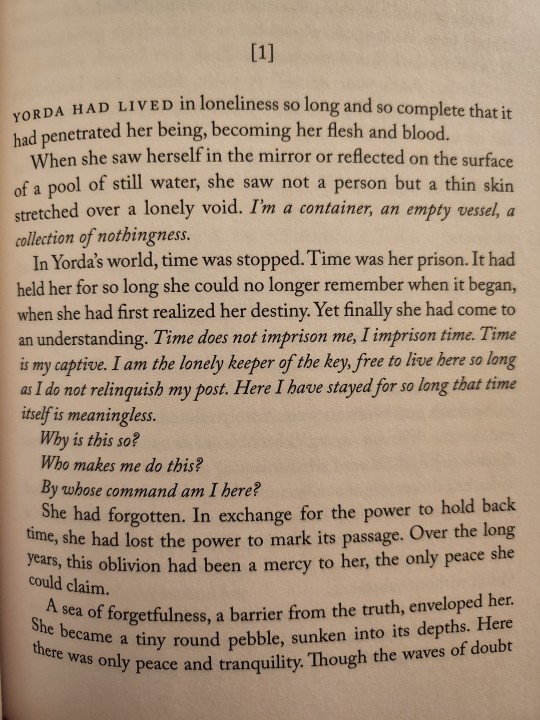
Time does not imprison me, I imprison time.
(Excerpt from ICO: Castle in the Mist, by Miyuki Miyabe; translated by Alexander O. Smith)
38 notes
·
View notes
Text
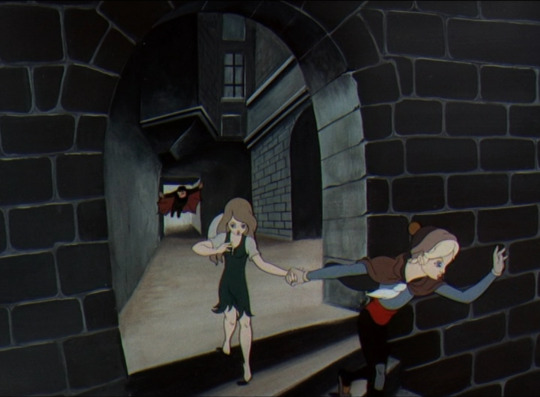

Fumito Ueda was inspired by… The King and the Mockingbird (Le Roi et l'Oiseau).
The King and the Mockingbird was clearly an inspiration for both Hayao Miyazaki and Fumito Ueda*. I've taken so many screenshots that look like scenes in The Castle of Cagliostro, Laputa: Castle in the Sky, Ico and Shadow of the Colossus that I can't include all of them in one post, so first I'm going to show you the ones that look like Ico. *In an interview for the 5th issue of Playstation Magazine (Italy) (July/August 2024), translated for a tumblr post by selene-lunette, Ueda named Paul Grimault as a source of inspiration. Le Roi et l'Oiseau has also been photographed on one of Ueda's bookshelves.
A chimney sweep and a shepherdess are the young couple escaping the castle, prefiguring Ico and Yorda. They come to life from paintings hanging next to each other and the reason they need to escape is because a painting of the king has also come to life, has got rid of the actual king, and is determined to marry the shepherdess.
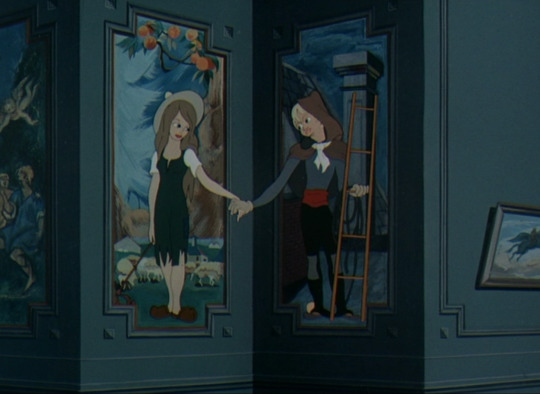
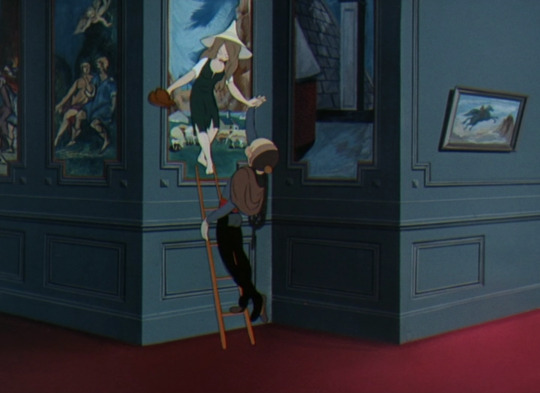


The narcissistic king has winged servants who chase after the shepherdess and the chimney sweep like the flying monkeys of The Wizard of Oz and surely inspiring the shadow creatures in Ico. I wonder if their design might come from the caped policemen that the French (and British) used to have.
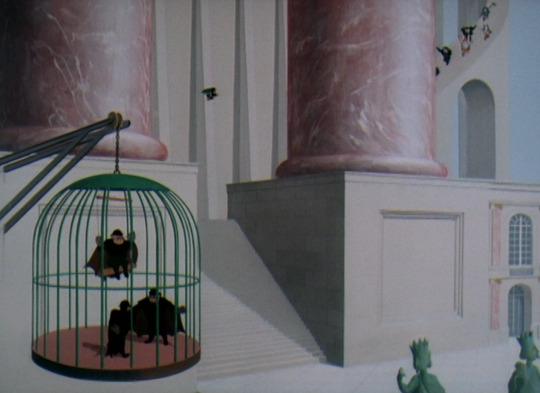
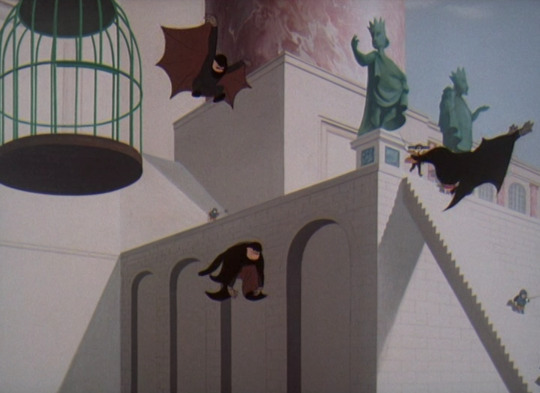



The mockingbird of the title looks after four hatchlings. One of them keeps getting trapped in a cage and on one occasion is freed when the cage falls to the ground and breaks open, just like when we first encounter Yorda in Ico.

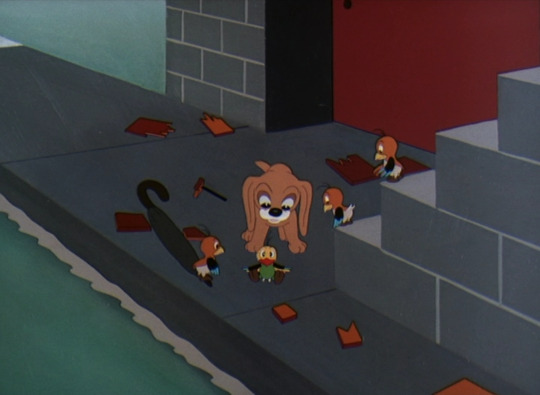
Towards the end, the king is trying to get away with the shepherdess, who is his unwilling bride. He steps onto a balcony area which then moves away from the palace and is revealed to be the helmet of the king's enormous robot, so it's like a combination of the retracting bridge from Ico and Malus in Shadow of the Colossus.
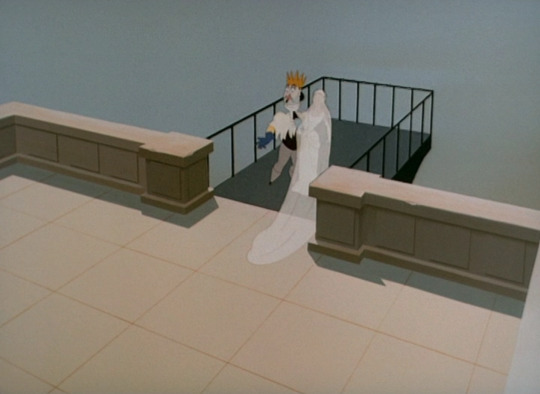

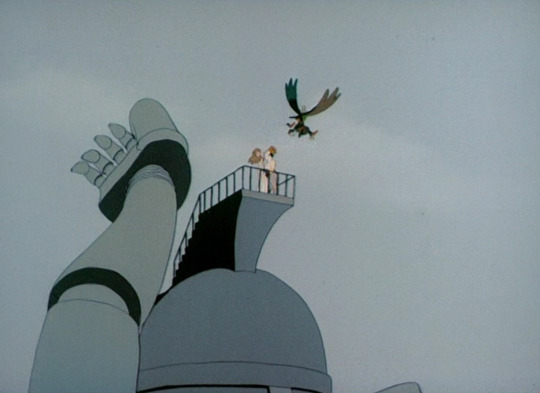
Not long after, it is the king, rather than our hero, who gets hit by a falling rock as the castle crumbles.
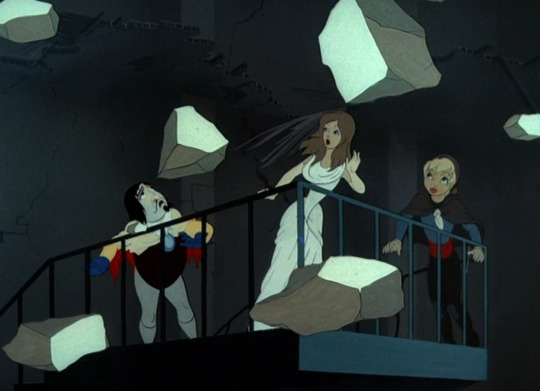

The soundtrack - When we’re looking at the paintings of the shepherdess and the chimney sweep (at 16 minutes 30 seconds) we hear a harpsichord melody called ‘La Bergere et le Ramoneur’ that's strikingly similar to 'Castle in the Mist'. Also, whenever the shepherdess and the chimney sweep need the mockingbird's help, they call out ‘Oiseau’ (pronounced ‘Wuh-zoh’) the way Ico calls out ‘Ontwuh’.
Ico's horns - They don't feature in this animation but perhaps they should because.... The King and the Mockingbird was adapted from a Hans Christian Andersen fairy tale called The Shepherdess and the Chimney Sweep. It tells the story of a shepherdess who is told she has to marry a creature with horns and the legs of a goat (a description of a satyr).
Is it any surprise at all that a fairy tale as beautiful as Ico should turn out to be traceable all the way back to none other than Hans Christian Andersen?
#the king and the mockingbird#le roi et l'oiseau#the shepherdess and the chimney sweep#ico#ico and yorda#yorda#fumito ueda#shadow of the colossus#hayao miyazaki#the castle of cagliostro#laputa#castle in the sky#hans christian andersen#flying creatures#wizard of oz#shadow creatures#jacques prevert#paul grimault#malus#robot#castle in the mist#horned boy#satyr#fumito ueda was inspired by
51 notes
·
View notes
Photo






More high resolution illustrations by Shinsaku Fujita for the serialized version of Miyuki Miyabe's novel 'Castle in the Mist'. These were obtained directly from the author. I wrote about their origin and purpose in greater depth in a previous post.
27 notes
·
View notes


























